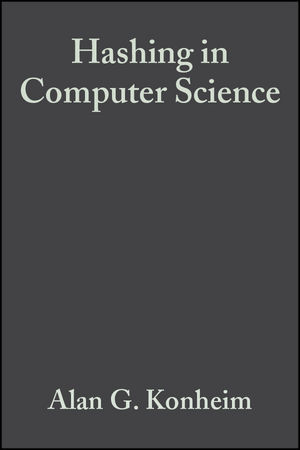Hashing in Computer Science: Fifty Years of Slicing and DicingISBN: 978-0-470-34473-6
Hardcover
408 pages
July 2010
 This is a Print-on-Demand title. It will be printed specifically to fill your order. Please allow an additional 10-15 days delivery time. The book is not returnable.
|
||||||
PART I: MATHEMATICAL PRELIMINARIES.
1. Counting.
1.1: The Sum and Product Rules.
1.2: Mathematical Induction.
1.3: Factorial.
1.4: Binomial Coefficients.
1.5: Multinomial Coefficients.
1.6: Permutations.
1.7: Combinations.
1.8: The Principle of Inclusion-Exclusion.
1.9: Partitions.
1.10: Relations.
1.11: Inverse Relations.
Appendix 1: Summations Involving Binomial Coefficients.
2. Recurrence and Generating Functions.
2.1: Recursions.
2.2: Generating Functions.
2.3: Linear Constant Coefficient Recursions.
2.4: Solving Homogeneous LCCRs Using Generating Functions.
2.5: The Catalan Recursion.
2.6: The Umbral Calculus.
2.7: Exponential Generating Functions.
2.8: Partitions of a Set: The Bell and Stirling Numbers.
2.9: Rouché’s Theorem and the Lagrange’s Inversion Formula.
3. Asymptotic Analysis.
3.1: Growth Notation for Sequences.
3.2: Asymptotic Sequences and Expansions.
3.3: Saddle Points.
3.4: Laplace’s Method.
3.5: The Saddle Point Method.
3.6: When Will the Saddle Point Method Work?
3.7: The Saddle Point Bounds.
3.8: Examples of Saddle Point Analysis.
4. Discrete Probability Theory.
4.1: The Origins of Probability Theory.
4.2: Chance Experiments, Sample Points, Spaces, and Events.
4.3: Random Variables.
4.4: Moments—Expectation and Variance.
4.5: The Birthday Paradox.
4.6: Conditional Probability and Independence.
4.7: The Law of Large Numbers (LLN).
4.8: The Central Limit Theorem (CLT).
4.9: Random Processes and Markov Chains.
5. Number Theory and Modern Algebra.
5.1: Prime Numbers.
5.2: Modular Arithmetic and the Euclidean Algorithm.
5.3: Modular Multiplication.
5.4: The Theorems of Fermat and Euler.
5.5: Fields and Extension Fields.
5.6: Factorization of Integers.
5.7: Testing Primality.
6. Basic Concepts of Cryptography.
6.1: The Lexicon of Cryptography.
6.2: Stream Ciphers.
6.3: Block Ciphers.
6.4: Secrecy Systems and Cryptanalysis.
6.5: Symmetric and Two-Key Cryptographic Systems.
6.6: The Appearance of Public Key Cryptographic systems.
6.7: A Multitude of Keys.
6.8: The RSA Cryptosystem.
6.9: Does PKC Solve the Problem of Key Distribution?
6.10: Elliptic Groups Over the Reals.
6.11: Elliptic Groups Over the Field Zm,2 .
6.12: Elliptic Group Cryptosystems.
6.13: The Menezes-Vanstone Elliptic Curve Cryptosystem.
6.14: Super-Singular Elliptic Curves.
PART II: HASHING FOR STORAGE: DATA MANAGEMENT.
7. Basic Concepts.
7.1: Overview of the Records Management Problem.
7.2: A Simple Storage Management Protocol: Plain Vanilla Chaining.
7.3: Record-Management with Sorted Keys.
8. Hash Functions.
8.1: The Origin of Hashing.
8.2: Hash Tables.
8.3: A Statistical Model for Hashing.
8.4: The Likelihood of Collisions.
9. Hashing Functions: Examples and Evaluation.
9.1: Overview: The Tradeoff of Randomization Versus Computational Simplicity.
9.2: Some Examples of Hashing Functions.
9.3: Performance of Hash Functions: Formulation.
9.4: The X2-Test.
9.5: Testing a Hash Function.
9.6: The McKenzie et al. Results.
10. Record Chaining with Hash Tables.
10.1: Separate Chaining of Records.
10.2: Analysis of Separate Chaining Hashing Sequences and the Chains They Create.
10.3: A Combinatorial Analysis of Separate Chaining.
10.4: Coalesced Chaining.
10.5: The Pittel-Yu Analysis of EICH Coalesced Chaining.
10.6: To Separate or to Coalesce; and Which Version? That Is the Question.
11. Perfect Hashing.
11.1: Overview.
11.2: Chichelli’s Construction.
12. The Uniform Hashing Model.
12.1: An Idealized Hashing Model.
12.2: The Asymptotics of Uniform Hashing.
12.3: Collision-Free Hashing.
13. Hashing with Linear Probing.
13.1: Formulation and Preliminaries.
13.2: Performance Measures for LP Hashing.
13.3: All Cells Other than HTn-1 in the Hash-Table of n Cells are Occupied.
13.4: m-Keys Hashed into a Hash Table of n Cells Leaving Cell HTn-1 Unoccupied.
13.5: The Probability Distribution for the Length of a Search.
13.6: Asymptotics.
13.7: Hashing with Linear Open Addressing: Coda.
13.8: A Possible Improvement to Linear Probing.
14. Double Hashing.
14.1: Formulation of Double Hashing.
14.2: Progressions and Strides.
14.3: The Number of Progressions Which Fill a Hash-Table Cell.
14.3.1: Progression Graphs.
14.4: Dominance.
14.5: Insertion-Cost Bounds Relating Uniform and Double Hashing.
14.6: UsuallyDoubleHash.
14.7: The UDH Chance Experiment and the Cost to Insert the Next Key by Double Hashing.
14.8: Proof of Equation (14.12a).
14.9: UsuallyDoubleHash.
14.10: Proof of Equation (14.12b).
15. Optimum Hashing.
15.1: The Ullman–Yao Framework.
15.1.1: The Ullman–Yao Hashing Functions.
15.1.2: Ullman–Yao INSERT(k) and SEARCH(k).
15.1.3: The Ullman–Yao Statistical Model.
15.2: The Rates at Which a Cell is Probed and Occupied.
15.3: Partitions of (i)Scenarios, (i)Subscenarios, and Their Skeletons.
15.3.1: (i)Subscenarios.
15.3.2: Skeletons.
15.4: Randomly Generated m-Scenarios.
15.5: Bounds on Random Sums.
15.6: Completing the Proof of Theorem 15.1.
PART III: SOME NOVEL APPLICATIONS OF HASHING.
16. Karp-Rabin String Searching.
16.1: Overview.
16.2: The Basic Karp-Rabin Hash-Fingerprint Algorithm.
16.3: The Plain Vanilla Karp-Rabin Fingerprint Algorithm.
16.4: Some Estimates on Prime Numbers.
16.5: The Cost of False Matches in the Plain Vanilla Karp-Rabin Fingerprint Algorithm.
16.6: Variations on the Plain Vanilla Karp-Rabin Fingerprint Algorithm.
16.7: A Nonhashing Karp-Rabin Fingerprint.
17. Hashing Rock and Roll.
17.1: Overview of Audio Fingerprinting .
17.2: The Basics of Fingerprinting Music.
17.3: Haar Wavelet Coding.
17.4: Min-Hash.
17.5: Some Commercial Fingerprinting Products.
18. Hashing in E-Commerce.
18.1: The Varied Applications of Cryptography.
18.2: Authentication.
18.3: The Need for Certificates.
18.4: Cryptographic Hash Functions.
18.5: X.509 Certificates and CCIT Standardization.
18.6: The Secure Socket Layer (SSL).
18.7: Trust on the Web ... Trust No One Over 40!
18.8: MD5.
18.9: Criticism of MD5.
18.10: The Wang-Yu Collision Attack.
18.11: Steven’s Improvement to the Wang-Yu Collision Attack.
18.12: The Chosen-Prefix Attack on MD5.
18.13: The Rogue CA Attack Scenario.
18.14: The Secure Hash Algorithms.
18.15: Criticism of SHA-1.
18.16: SHA-2.
18.17: What Now?
Appendix 18: Sketch of the Steven’s Chosen Prefix Attack.
19. Hashing and the Secure Distribution of Digital Media.
19.1: Overview.
19.2: Intellectual Property (Copyrights and Patents).
19.3: Steganography.
19.4: Boil, Boil, Toil ... and But First, Carefully Mix.
19.5: Software Distribution Systems.
19.6: Watermarks.
19.7: An Image-Processing Technique for Watermarking.
19.8: Using Geometric Hashing to Watermark Images.
19.9: Biometrics and Hashing.
19.10: The Dongle.
Appendix 19: Reed-Solomon and Hadamard Coding.
Exercises and Solutions.
INDEX.



